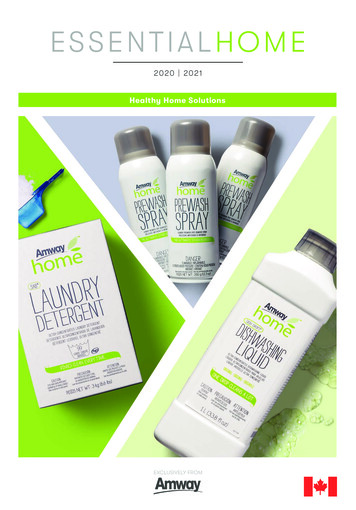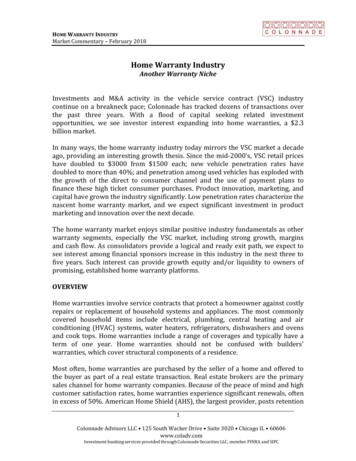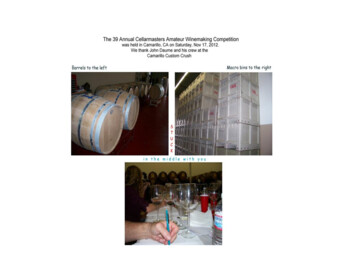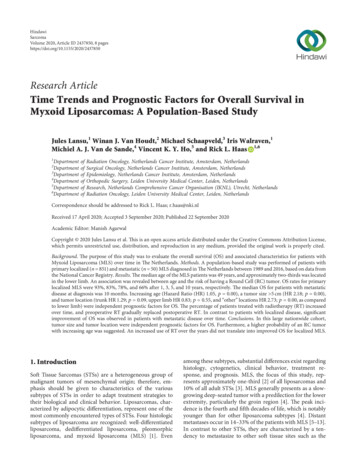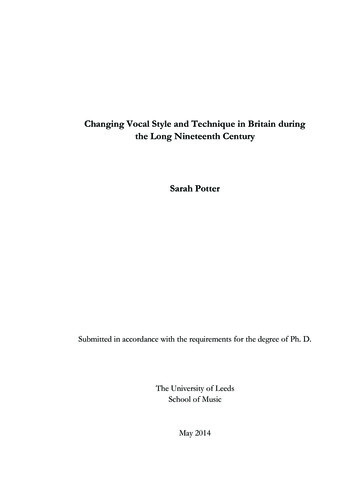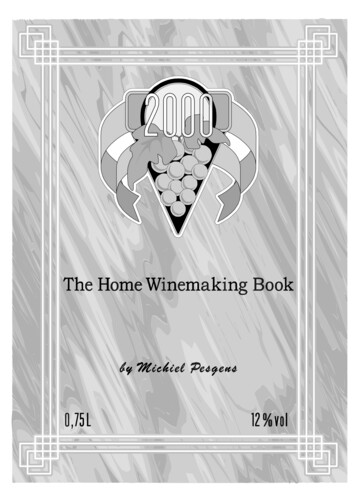
Transcription
Michiel PesgensThe Home Winemaking BookPrefaceThe basis of this book was the content of my internet page "The Home Winemaking Page". The root ofthis book is the "Procedures" chapter. The other chapter are built around it, but can also be readseparately.Every winemaker has a different view on winemaking. As your winemaking skills evolve, you'll startcombining methods and views from others and eventually you'll create your own. That's why thefollowing reflects my view on home winemaking.I consider home winemaking as a very rewarding hobby and I wrote this book to share it with you. If youread all the info, you should be able to successfully produce your own batch of wine.Enjoy the winemaking hobby!Michiel Pesgensmipeman@yahoo.comThe Home Winemaking BookCopyright 2000 by Michiel PesgensThe electronic version of this book as well as downloads can be found at:http://www.geocities.com/NapaValley/82802
Michiel PesgensThe Home Winemaking BookContentsProcedureGetting startedPreparing the mustMaking the yeast starterPrimary fermentationRacking to secondarySecondary fermentationTopping upRackingBottlingCorkingLabeling and capsulingBottle agingDrinking44455667788999Sugar and alcohol10Measuring the specific gravityCalculating sugar and alcohol before fermentationCalculating the alcohol content after fermentationMeasuring the alcohol content after fermentationMaking a sweet wine1010121213Measuring the acid contentRaising the acid contentLowering the acid content151516Acids15Equipment and er's log21Recipes22Beginner’s recipesAdvanced recipes2223Label makingMaking labels using a wordprocessorMaking labels using a paint programPrinting labelsLabeling2525252626Conversion tablesWineVolume and weightAdding acidSweeteningTemperatureBlendingSG, sugar / litre and alcoholMust and sugar / litreGlossary272727272727272727283
Michiel PesgensThe Home Winemaking BookProcedureGetting startedFirst thing you need is a recipe. You find recipes on the web or in winemaking books or you can composeyour own recipe by combining several recipes. You can find a couple of recipes I've tested myself in theRecipes chapter.If you want to compose a recipe yourself, measure the acidity with an acid test kit. Adjust the acidity tothe amount you like, typically 5 to 8 g/l for wine. See the Acids chapter for more info on this subject.Check if the recipe requires a juice fermentation (for white wines) or a pulp fermentation (for red or blushwines). Both require their own approach to the first stages of winemaking.Specific procedures for pulp and juice fermentations for red and white wines respectively will beindicated with the bold headings red and white.whiteA juice fermentation must be used for making white wines. In this case juice is extracted from the fruit bypressing (with a wine press) and then fermented in a carboy or fermentation bottle (secondary fermentor).redA pulp fermentation is used to maximize color and flavour extraction, necessary in making red wines. Itbasically means making a pulp of fruit by crushing and fermenting on the pulp without extracting juicefirst. This can't be done in a carboy (secondary fermentor), but in a primary fermentor like a bucket. Thisfermentor must be sealable against the air and vinegar flies to some extent e.g. by placing a lid on topwith an airlock or you can use a plastic bag attached to the top with a rubber band. Be inventive.For beginners, it's best to start with some juice or concentrate bought in a shop. This is easy to start withand requires little equipment. This way you can start with a juice fermentation without having to press thefruit with a wine press, and avoiding a pulp fermentation.Keep records of all ingredients and all events. See the Winemaker's log chapter.Preparing the mustSanitize your must to kill wild yeast and bacteria. This can be done by means of: Adding sulphite or crushed campden tablets (1g/10kg), the most common way Pouring boiling water over fruit, to kill most wild yeast and bacteria on the fruit skins Boiling, this helps extracting juice, but can result in change of flavour and could cause a pectin haze,if not using pectic enzymeThe sulphite is the most commonly used and probably the best way.Crush the fruit, try to be inventive. A home made pulp cutter on a drilling machine can be very handy.Juice fermentation requires the extraction of juices now. This can be done by boiling or by means ofpressing.Clean fermenting vessel and other material and rinse it with a sulphite solution to sterilize it.Fill the fermentor with the must and add water, and other ingredients that the recipe calls for except thesugar and yeast.Take a hydrometer reading first. Calculate the amount of sugar needed for the desired alcohol content.For more info on this subject, see the Sugar and alcohol chapter.Dissolve the sugar and take a reading of the starting SG (Specific Gravity). If you have't got ahydrometer, add the sugar according to the recipe. Take out some must with a measuring jar, dissolve thesugar and gently pour off the liquid. This way all the sugar gets dissolved properly. You can boil thewater before adding to the must and dissolve the sugar in the hot water first.Crush and dissolve one campden tablet and add it to the must if you haven't already done so and let itstand for 24 hours for the sulphite to do its thing. For more info on sulphite use see the Sulphite chapter.Leave some room (at least 1/5) on top, otherwise the foam will leave you with a big mess when thefermentation starts and the fermentor overflows.4
Michiel PesgensThe Home Winemaking BookredCover the primary fermentor with a lid that doesn't close perfectly or use a plastic bag with a rubber band.Air must be able to get in to promote yeast growth during the first few days. Further, the carbon dioxidegas produced by the fermenting process must be able to escape. Vinegar flies must be kept out. A lid witha hole would be best, a piece of cotton or a paper towel could be applied.Try making a little more wine than your secondary fermenting vessel can take for topping up purposeswhen racking later on.whitePlug the bottle with some wadding or a paper towel to allow oxygen into the bottle and to keep fruit fliesout. This is necessary to promote yeast growth during the first few days. Fill the carboy to 4/5 part. Putthe rest of the wine in another bottle, so that you can completely fill the carboy later on in the process.Making the yeast starterA yeast starter can be made (24 hours before fermentation start), but rehydrating the yeast is usuallysufficient (about 15 minutes before fermentation start) if you are not making large batches of wine (lessthan 10 liters). A yeast starter gives the fermentation a more vigorous start.For a simple yeast starter you'll need: Must (5 to 10 % of the amount to be fermented)Sugar (when the must contains little sugar)Small amount of yeast nutrientSmall amount of citric acid (or some lemon juice)Wine yeastSlightly heat the juice until lukewarm (about 30 degrees Celsius), nutrient and the citric acid. Put thismixture in a sterile bottle. Add the yeast and stir well. Cover with some wadding. Let it stand for about 24hours untill foam has formed. When foam has formed, it is ready to be added to the must.Another way to prepare the yeast is rehydration. Rehydration means dissolving the yeast in half a glass oftepid water and letting it stand for about 15 minutes. You can toss in a teaspoon of sugar to give itsomething to do. This of course must be done the day you're going to start the fermentation.When you're lazy, just sprinkle the yeast on the must.A yeast starter usually works best and it's necessary for larger quantities. For smaller quantities,rehydration usually is sufficient. The faster the must will start to ferment, the better. A yeast starter is thefastest way, rehydration comes next, and just adding the yeast dry takes the longest untill fermentationstart. The longer the period before fermentation gets going, the more chance oxygen, bacteria and moldget to spoil your wine.whiteGo to the Secondary fermentation paragraph and skip the ones in between.Primary fermentationred24 hours after the campden tablet has been dissolved in the must, the yeast starter can beadded to the must.The actual start of fermentation will take place within about 2 days after adding thestarter. This will be perceptable due to foam formation and bubbles will start risingtowards the surface.Pulp fermentation generally takes a few days to a week.Foam will form in the primary fermentation vessel, but as it should be significantly largerthan the amount of must to be fermented, the foam shouldn't be a problem.The rising bubbles will cause a cap of fruit pulp to form on top, which must be pressed down at least oncea day to keep it submerged to avoid mold growth. This can be done using a clean spoon. Pressing alsomaximizes color and flavour extraction.5
Michiel PesgensThe Home Winemaking BookTransfer to secondary redWhen the color and tannin extraction has been sufficient (a few days to a weekafter fermentation start) the must needs to be transferred to the secondaryfermentor (a carboy or jug). The sediment and cap have to be separated fromthe wine. This can be done in a process called straining.You may want to take a hydrometer reading here, if you have one. It shouldread about SG 1030.Straining can be done like this:Clean the secondary fermentor and all equipment and rinse all with a sulphitesolution. Wash your hands carefully.Clean and sterilize another bucket and put a nylon straining bag into it.Pour the must through the straining bag. You can use a measuring cup to dothis. Avoid excess splashing.Take the bag out of the must and gently press the liquid out.Dispose of the solids.Pour the wine into the secondary fermentation vessel through a large funnel.Put some cheesecloth over the funnel to catch small solid particles. If thecheesecloth becomes filled with particles and the flow through it is sloweddown too much, pull the cloth a bit aside, such that a clean part covers thefunnel.After straining, place an airlock on top of the bottle.Do not fill the carboy completely yet, because of overflow danger. If you've made some excess wine thatdoesn't fit the carboy, put it into a smaller bottle, also under airlock. You can use it for topping up whileracking later on in the process.Secondary fermentationredAfter primary fermentation (and having racked the wine to thesecondary fermentor when you've pulp fermented) the nextfermentation step starts, the secondary fermentation (obvious isn'tit?). Fermentation will continue here, but not as vigorously asprimary fermentation. Fill your carboy almost to the top, when nofoam is being formed any more.Place a bung and airlock on top of the carboy.whiteWhen fermenting clear juice, you've skipped a few paragraphs. Theprocess continues here.You'll only fill the carboy for 4/5 part. Fill another bottle with juice so you'll be able to fill up the headspace later on.Add the yeast starter and get both bottles fermenting. Put a piece of wadding in the neck of the bottles tokeep fruit flies out.Foam will form on top of the must due to rising bubbles. That's why you only filled the carboy partially.The amount of foam depends on the ingredients used and fermentation conditions. Although you've onlyfilled the bottle partially, the danger of overflowing still exists. That's why it's a good idea to place yourcarboy somewhere where spillage can't hurt like in a bucket or bath tub.When the yeast has started doing its work, put a fermentation lock in place of the wadding.When fermentation slows down (you can tell by the bubbling rate of the airlock or by hydrometerreadings) it's time to add the rest of the total amount of sugar required if you want to get a higher alcohol6
Michiel PesgensThe Home Winemaking Bookcontent. The SG should be about 1010 now. It's best to add the sugar in several steps. Take a hydrometerreading before and after each sugar addition to be able to calculate the alcohol content when the wine isfinished. Siphon off some wine, dissolve the sugar in it and siphon back. Notice that dissolved sugarneeds some bottle space. Don't just throw dry sugar into the wine, unless you want to get a volcano foameruption. Even worse, most sugar will sink to the bottom, not dissolving completely.Topping upWhen the fermentation process really slows down (usually after a month or so) and allsugar has been added, you need to fill the bottle all the way to the top to minimize thesurface area. This should be done because the wine doesn't provide itself a CO2 blanketany more (only during vigorous fermentation), and could oxidize (and get spoiled).Use the excess wine you've made to top up, use a similar wine, or water.RackingWhen the wine has stopped fermenting (it has stopped bubbling) it has to be racked.The wine has to be siphoned to another bottle leaving the sediment behind. The process has to be doneseveral times so that you end up with a clear batch of wine. You'd better practice with some water first, ifyou've never racked before to avoid spilling the wine.Racking is done like this: Find a carboy or big bottle to take all the wine. Clean the bottle and all equipment and sterilize all with a sulphite solution.Rinse with water. Dissolve a crushed campden tablet in half a glass of water and pour it into theempty bottle. Now put the full bottle a little higher (not over 1 m) than the bottle about tobe filled. Place it on a kitchen chair or table for instance and the other one onthe ground. Place the siphoning hose into the must and suck untill the wine starts to flow.Pay attention not to suck up the lees. Then pinch the hose and lower it into the other bottle. Release the tube andthe wine will start flowing. Avoid vigorous splashing (to avoid oxidation). Stop the flow just before sucking up sediment. To avoid losing the wine mixed with lees, you can pour the remainder into a small bottle and let itstand overnight in a cool place like a refrigerator. The next day you can pour the wine off the lees andadd it back to the rest of the wine. Rinse out the sediment. Use a bottle brush, if necessary. If the bottle in which the wine is now is bigger than the original one, siphon the wine back again. You will lose some volume here, so you'll have to refill the bottle to the top. You can use someexcess wine you made by fermenting in a small bottle beside the carboy. If you didn't you can top itoff with a similar wine or use water. Make sure that you've refilled the fermentation bottle within aday to avoid too much oxidation.You'll have to repeat this sequence every time a reasonably thick layer of sediment has accumulated untillthe wine is clear. About three rackings should do. If the wine doesn't clear out of itself, there are finingagents like bentonite to help you out. If you don't mind the haze, don't worry.7
Michiel PesgensThe Home Winemaking BookBottlingWhen the wine is clear, and the fermentation process has fully ceased, the wine canbe bottled. Take the hydrometer if you have one to check for residual sugars and tobe able to calculate the alcohol content. The Sugar and alcohol chapter explains howto do thisThe wine can also be matured in the fermentation bottle (bulk aged), but if youhaven't got that many of those the choice is easy. Beware that if you bottle too soon,your corks might start popping out due to re-fermentation in the bottle, and leaveyou with a terrible mess. So it's best to wait a few months after fermentation stop tomake sure that fermentation has fully ceased and the wine is stable.Just before the actual bottling, the wine can be sweetened to taste. Check the Sugarand alcohol chapter on how to do this.Use green or brown glass bottles for red wines, and white or colored bottles forwhite wines. The easiest bottle to work with is the Bordeaux type (easy to pile up).Here is the bottling procedure: 24 hours before bottling add one crushed campden tablet to the wine. Add potassium sorbate andsugar, if you want to obtain a sweet wine. Prepare corking, as this follows the bottling procedure immediately. Bottling requires some wine bottles which should have been cleaned when you got them. Just beforebottling rinse them with a sulphite solution and drain them. This can be done by filling one bottle for3/4. Shake well and use a funnel to transfer the solution to the next bottle. Filling the bottles can be done with your siphoning tube. This is done likeracking, only now you don't have to worry about the lees. Bottles need to befilled to about 1 cm below the cork. Don't try to fill the bottles exactly to tothis level in one operation, but stop the flow a little earlier and top up a funnelafterwards to avoid spilling the wine. When you exchange bottles, you'll have to stop the flow. This can be done bypinching the hose. Another way to stop the flow is by lifting the bottle to the same level as thefermenting bottle. But don't lift it too high, or the wine will flow back and out of the hose and you'llhave to suck again. A little tap attached to your siphoning hose together with another piece of hose toreach the bottom of the wine bottles facilitates bottling.Move right on to the next step.CorkingNow that you've just finished filling your bottles it's necessary to cork them (if you've chosen to use winebottles). Corking bottles really can't be done without a corking machine (believe me, I've tried). Thiscould use some practice. When you're not making large quantities a hand held corking tool will do. Largequantities require a floor corker.Here's how: 12 to 24 hours before bottling soak your corks in a sulphite solution to sterilize them and to makethem more flexible. Make sure that the corks are fully submerged, so put some weight on top. Insert a cork in the device. and put it on top of the bottle. Push very hard untill the cork is in place. Take the corker off. If the cork hasn't been driven deep enough into the neck of the bottle, adjust the corker. If you've gota hand corker, put only the upper part of the device on the cork, and hammer it down with a woodenor rubber hammer. Do not try pushing while using only the upper part of the corker because the corkwill overshoot and end up in the wine. Freshly corked bottles are best left standing up straight for a few days in order to prevent winespillage due to popping corks (they still could pop, put a bottle standing won't leak empty). Corkscould pop due to the force of the wine and compressed air. This risk goes away after a couple of days.8
Michiel Pesgens The Home Winemaking BookEventually the bottles must be layed on their sides, otherwise the corks will dry out, leak, and thewine will oxidize.Labeling and capsulingAll bottles should be labeled. It is necessary to identify the type of wine, but a nicelabel also looks better.A couple of things that could appear on it are: type of fruit, sweet/dry, year, month,date of fermentation start and bottling date, type of wine, your name, %vol alcohol.You can buy labels ready made or you can have some custom designed for you. Buthomemade wine looks good with homemade labels. Labels can be made with pen andpaper or on the computer. Almost every paint program or wordprocessor can producenice labels.For more info on making wine labels with a computer, see the Label making chapter.Labels are best glued on with water soluble glue like Pritt or UHU stick. This is necessary for gettingthem off easily in order to reuse the bottle.You can use capsules to cover the top of the bottle neck and the cork. It is mainly for decorative purposes.Most capsules must be heated to attach them to the bottle neck. This can be done by means of a candle ora heat gun for removing old paintwork. Pouring boiling water over them also works. Of course this mustbe done before labeling.Bottle agingAging means letting your wine lie down for a period of time before consumption so that its qualityimproves. This can be done before (bulk aging) or after bottling (bottle aging).Almost every wine improves with time. A few months will cause significant change, a year or more willbe better.This process doesn't continue into infinity. There is something like a peak in quality, but most wine isbeing drunk too early. The time that home made wine will ages usually depends on how long you canbare to wait. A typical aging time for your first bottle is something between 1 second and one week afterbottling. So the more wine you make, the better chance it gets to age.To age wines you need a place where it is dark and where temperature is cool and relatively constant.DrinkingThat's what it's all about! Consuming your wine. You can drink it with some company so that you getopinions from outsiders about your wine.It may taste different from commercial wine, you should be aware that you've really made something a bitspecial.Use wine glasses, if you have some available. White wine should be drunk rather cool, red wine at roomtemperature.Enjoy!9
Michiel PesgensThe Home Winemaking BookSugar and alcoholThis chapter will explain how the sugar and alcohol content of a must or wine can be measured,calculated and adjusted.The sugar content is usually expressed in grammes of sugar per liter (g/l) of must or wine.Sugar present in the must and the final alcohol content in the wine are correllated.Measuring and adjusting the sugar and alcohol content of a wine or must is better than just adding theamounts of sugar stated in a recipe. The amounts of sugar in a recipe can differ much from the amountneeded to get the same final alcohol content than in the recipe. This is because the other ingredients in themust also contain sugars, and that content is never the same. It depends on a lot of factors like the amountof sun the fruit got that year, the location where grown etc.The sugar content of a wine or must cannot be measured directly. The specific gravity (SG) is measuredand is expressed in grammes per liter (g/l). Another scale is degrees Oëchsle ( Oë) which is equivalentwith SG-SGwater, thus SG-1000.The SG of a wine or must is roughly equivalent to the sugar content of a must, so that the sugar contentcan be calculated.The alcohol content is expressed in percents by volume (%vol). Most commercial wines have an alcoholcontent between 9 and 12 %vol.Measuring the Specific GravityThe hydrometer is a device which can be used to measure thespecific gravity of a fluid or solution. To take readings, you alsoneed a hydrometer jar, which is often also a measuring cylinder.This is the procedure to take a SG reading: Take a sample of the wine or must to be measured, whichcontains no solid particles. Fill the jar for about 4/5 withwine or must. Place the cylinder on a straight surface and gently lower thehydrometer into the cylinder, so that it doesn't hit thebottom. Make sure the hydrometer floats freely and does not touch the sides of the cylinder. When you look closely at the fluid surface it is slightly curved, which is called the meniscus. Nowtake a reading of the number that matches the lower part of the meniscus, see the figure on the right.In this case the SG is 1080. Take the hydrometer out, clean and put it away. The sample of wine or must can be added back to therest of the batch. Clean the jar and put it away.Calculating sugar and alcohol before fermentationAfter taking a hydrometer reading of the must to be fermented, the amount of sugar that should be addedto reach a certain alcohol level in the wine can be calculated on two ways. The first way is by using thehydrometer table and the second is by using a couple of easy formulas.When not using a hydrometer, just use the amount of sugar stated in the recipe you are following,although this a very unreliable method.When calculating the sugar to be added before fermentation, it is a good thing to keep the starting SGbelow 1100 to avoid a stuck fermentation. Here is how both ways of computation can be performed:10
Michiel Pesgens The Home Winemaking BookCalculating sugar and alcohol using the hydrometer tableSugar and possible alcohol content can be calculated using the hydrometer table printed below.Hydrometer tableSpecificPotentialGrammesgravity%vol alcohol sugar / 15112517.0327.5113017.7340113518.4352ExampleWe want to get 10 litres of wine with 12.5 %vol alcohol content.The must has an SG of 1035.Amount of sugar present in must:SG 1035 gives us 95 g / litre10 * 95 950 gAmount of sugar needed at fermentation start:(a good starting SG for a must is SG 1080, which equals 208 grammes sugar/l)SG 1080 gives us 208 g / litre10 * 208 2080 gAmount of sugar needed totally:12.5 %vol doesn't exist, so we look at 12.7 %vol and take a bit less. This gives us 250 g / litre10 * 250 2500 gAmount of sugar to be added totally:2500 - 950 1550 gAmount of sugar to be added before fermentation start:2080 - 950 1130 gAmount of sugar to be added during fermentation:2500 - 2080 420 g11
Michiel Pesgens The Home Winemaking BookCalculating sugar and alcohol by using some simple formulasThe simplest way to calculate sugar and possible alcohol content is by using a few simple formulas. Don'tuse this method if you plan to ferment to an alcohol content below about 10 %vol (which will not occurvery often, I guess).We'll use these relations:1 Oë1 % alcoholSG water1 % acid 2.719100010g sugar/lg sugar/lkg/m3g/lExample (same as above)We want to get 10 litres of wine with 12.5 %vol alcohol content.The must has an SG of 1035. Amount of sugar present in must:(1035 - 1000) * 2.7 * 10 945 gAmount of sugar needed at fermentation start:(a good starting SG for a must is SG 1080, which equals 208 grammes sugar/l)(1080 - 1000) * 2.7 * 10 2160 gAmount of sugar needed totally:12.5 * 19 * 10 2375gAmount of sugar to be added totally:2375 - 945 1430 gAmount of sugar to be added before fermentation start:2160 - 945 1215 gAmount of sugar to be added during fermentation:2375 - 2160 215 gCalculating the alcohol content after fermentationWhen fermentation has stopped, the final alcohol content can be calculated using the starting and final SGreadings. The following formula can be used:Alcohol content (SG start SG final )7.36ExampleThe wine started with a SG of 1080, and ended with a SG of 992. The alcohol content of the wine shouldbe:(1080 - 992) / 7.36 12.0 %volMeasuring the alcohol content after fermentationOf course, if you've taken proper hydrometer readings, you can calculate the amount of alcohol formed inyour wine. But if you haven't got one or want to check your calculations, you can use a vinometer. Butthere is one mayor restriction: A vinometer can only produce accurate results in a dry wine (containinglittle or no residual sugar). The vinometer works on the principle of capillary action, so it actuallymeasures viscosity, which is dependant on the alcohol/water ratio. It has a scale of alcohol content12
Michiel PesgensThe Home Winemaking Bookmarked on it.The procedure goes as folllows (note the image on the right): Fill the vinometer with some dry wine. Wait untill some drops have fallen through. If the wine doesn't start toflow on its own, put your mouth on the funnel-side of the vinometer andblow gently. Then put a finger on the part where the drops form and turn it upsidedown. Place the vinometer on a straight surface. You might want to place it on asmall plate to avoid making a mess. Release the finger. The level in the capillary will drop to a certain level,which indicates the alcohol content of the sample (the arrow). Take two more measurements and take the average value of themeasurements:Average (Measurement 1 Measurement 2 Measurement 3) / 3 Clean the vinometer and store it away.Making a sweet wineThe trick of making sweet wines is to prevent yeast cells from fermenting the sugar you'll add to make thewine sweet. So the yeast cells must be gone or the time the sugar is present should be so short, that theyeast cells haven't got time to make alcohol from it.So it's not that easy to make a sweet wine. It takes longer than a dry wine and there's always a risk ofrefermentation in the bottle.Basically there are four ways to make sweet wine: Adding sugar just before you drink itJust before serving, add a few teaspoons of sugar to your wine. A sugar syrup of invert-sugar worksbest.This way you've always got dry wine which you can turn into sweet wine when necessary. Sweetwine cannot be made dry again. So you can make 2 wines from 1 bottle. The greatest advantage ofthis method is that you do not run the risk of refermentation.Adding liquorBefore the wine has completely fermented out, pure alcohol or another high-alcohol liquor is added tothe wine exceeding the level that the yeast can tolerate. This is about 16 %vol. The blending ratio canbe calculated just like explained in the Acids chapter. Port and sherry wines are made using thismethod.FilteringThe wine can also be filtered after it has fermented out and it is stable. A very fine filter is required toget all the yeast cells out. This method is usually the way commercial sweet wines are made. But youreally need a good filter. The wine can then be sweetened.Using potassium sorbateFirst ferment to dryness, let the wine clear and rack it. It must be brilliantly clear and no yeast may bepresent any more. Often filtering is done to speed up the process. The wine is then aged. The winemust be absolutely stable. Then sugar can be added to taste, sulphite and potassium sorbate must beadded. Potassium sorbate inhibits the last few yeast cells from reproducing. So it doesn't stop theyeast from fermenti
Michiel Pesgens The Home Winemaking Book 4 Procedure Getting started First thing you need is a recipe. You find recipes on the web or in winemaking books or you can compose your own recipe by combining several recipes. You can find a cou



